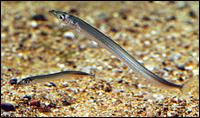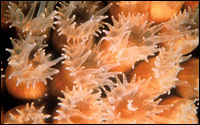
Guillemots are disappearing …
Photo: Dr. Brian Wilson, Centre for
Bioscience ImageBank.
On the south side of the isle of Shetland, off the coast of Scotland, there are more than 1,200 guillemot nests. Last spring, all of them were empty.
No pear-shaped eggs, no downy chicks, no next generation of guillemots.
Elsewhere on Shetland, the scene was even more disheartening: 24,000 nests of another seabird, the arctic tern, were almost entirely empty. A few miles away on the island of Foula, the world’s largest colony of great skuas saw only a few living chicks. British ornithologists have never seen anything like this devastation, which reaches as far south as Yorkshire and includes the loss of hundreds of thousands of seabirds.
The problem is that the adult birds are starving. They eat sandeels, a small, silvery fish that normally teems in the surrounding waters of the North Sea. In the past year, though, the sandeels have disappeared and there is little alternative prey. Each day, the birds fly farther and farther, soaring many miles out from shore and diving up to 300 feet underwater in search of food. But most have not found enough sandeels to provide the needed energy to lay eggs.

… because sandeels are
disappearing …
After much investigation, scientists think they’ve uncovered the root cause of the disaster. They believe the sandeels are disappearing because the cold-water plankton that the fish prefer to eat has migrated north. And the plankton has moved because the traditionally frigid waters between England and Scandinavia have become too warm for it to survive there. Climate change is heating northern latitudes much faster than it is the equator, while also weakening ocean currents. The combination of these and other factors has warmed the North Sea by as much as 3.6 degrees Fahrenheit over the last 20 years, causing some species of plankton to shift northward, while others bloom a full month earlier than they did in the 1960s. Meanwhile, warm-water and subtropical fish like squid and red mullet are becoming common in the once-cold sea.
Arctic terns, unfortunately, cannot feed on squid. The result is a chain of environmental cause-and-effect calamity that reverberates through the predator-prey relationship, a phenomenon known as “trophic cascade.” Since 1984, as the North Sea has warmed, some seabird species around Scotland have decreased by 60 to 70 percent, says Morton Frederiksen of the Center for Ecology and Hydrology at Banchory, U.K. Meanwhile, many Danish commercial fisheries are suffering severe financial consequences; last year, they couldn’t catch even half their legal quota of sandeels.

… because plankton are
moving northward.
Food-Chain Reaction
Phytoplankton are mostly unicellular creatures that float near the ocean’s surface. Under a microscope, they look like whimsical Chinese hats, transparent kitchen strainers, and beautiful mechanical pieces machined for a device you can’t quite imagine. But as minuscule as they may be, their importance to life on earth cannot be overstated.
Phytoplankton, among the smallest of all plants, are the world’s main photosynthesizer, producing an estimated 50 percent of the planet’s free oxygen. They also form the base of the oceanic food chain. Almost everything in the sea consumes phytoplankton, or consumes the predators of phytoplankton, or the predators of those predators. If the total amount of these tiny organisms produced each year could be massed together on one giant scale, they would weigh more than the annual growth of all terrestrial organisms combined. (That’s counting every species, from beetles to redwoods to elephants.) So a climate change-induced disturbance of planetary phytoplankton lifecycles could impact nearly every sea species, as well as humans and other animals that rely on the ocean’s bounty.
The vast climate-driven migrations of phytoplankton populations in the North Sea provide a vivid example of the potential ripple effect. Over the last 40 years, warming seas in the region have resulted in some warm-water-loving plankton species around Britain migrating northward by 10 degrees in latitude, while cold-water species have been driven toward the poles. Unfortunately, the North Sea sandeels prefer feeding on cold-water plankton because those species are bigger, on average, than warm-water plankton, and thus provide more calories. Scientists surmise that this subtle difference in plankton size is what has led to a plummeting sandeel stock, and thus to fewer seabirds of all kinds in the region. But size isn’t the only thing that matters. If a newly prevalent phytoplankton species blooms earlier or later than a past prevalent species, or is harder to digest, or possesses fewer nutrients, then the change can spread harmfully across an entire marine ecosystem.
As serious as the plankton migration problem is, it may only be the tip of a rapidly melting iceberg. Global warming has also significantly reduced overall phytoplankton numbers. Worldwide, the seas’ surface temperature has increased by an average 0.36 degrees Fahrenheit over the last 20 years. While this might not seem like a big rise, it is altering the way the world’s ocean waters mix. Global warming is increasing the stratification of seawater because, as NASA biologist Watson Gregg explains, “the top warmest layer of ocean water becomes lighter as it warms.” The increasing weight difference between warm surface water and deeper cold water decreases the ability of the layers to mix, making them almost like oil and water, and thereby diminishing the amount of nutrients that can cycle to the top of the seas. And it is these vital deep-sea nutrients that are critical to the survival of phytoplankton.
Already, the decrease in annual phytoplankton blooms resulting from the lack of nutrients at the oceans’ surface is significant enough to be seen from space. By recalibrating old satellite imagery to search for the green of phytoplankton’s chlorophyll, Margarita Conkright from the National Oceanic and Atmospheric Administration and Watson Gregg of NASA’s Goddard Space Flight Center found that phytoplankton has declined 6 percent since the early 1980s. And while the satellite photos can’t show it, Conkright and Gregg know that fewer of these microscopic plants also mean fewer whales, cod, penguins, seals, salmon, and seabirds, as well as diminished catches for global fisheries.
And those are just some of the species that will be affected. Although phytoplankton lives at the ocean’s surface, a crash in its population could affect life all the way down to the ocean floor. Scientists now believe that the greatest diversity of life on earth may exist in the dark depths of the seas, where up to 10 million species could live, ranging from single-celled protists to fish that look like they were designed by Dr. Seuss. Most of these species have never been seen or catalogued by humans. As global warming escalates ocean stratification, oxygen-rich water and organic material (primarily in the form of dead and decaying plankton) are failing to reach this vast underworld. A 14-year study by Henry Ruhl and Ken Smith at the Scripps Institute of Oceanography recently showed that climatic variation doesn’t take decades to adversely affect the food supply miles below the surface. Starvation for many species starts in a matter of months. As a result, a significant portion of ocean-floor species might quickly disappear.
Global warming isn’t the only way in which humanity’s fossil-fuel use is changing the world’s oceans. Emissions from tailpipes and smokestacks are also altering basic ocean chemistry by dramatically increasing the amounts of carbon dioxide in seawater. A new international study led by NOAA scientists sampled ocean water in thousands of places around the world and discovered that the seas have absorbed almost half of the 244 billion metric tons of CO2 that humans have released in the last two centuries. These heightened CO2 levels are making the oceans more acidic than they’ve likely been in several million years. Oceanographers are especially worried about what will happen if the level of atmospheric CO2 doubles from the 280 parts per million level at the beginning of the industrial revolution to 560 parts per million, a threshold that could be reached as early as 2050. Such a significant boost would translate to an increased CO2 load absorbed by the oceans, and further acidification.

Coral polyps could be in trouble, too.
In this acidified water, shellfish, ranging from oysters to sea urchins, have an increasingly hard time growing their calcium carbonate shells. The sea creatures most likely to be affected by future acidity will be small, thin-shelled organisms, such as the coral polyps that create reefs and the significant portion of plankton species that have shells. (When biology professor Vicky Fabry of California State University at San Marcos put a pteropod — a species of plankton with a shell — into a container of water surrounded by air containing 700 parts per million CO2, the shell began to visibly dissolve within 48 hours.) This is bad news on two counts. Coral reefs — one of the planet’s richest ecosystems — have already been badly damaged by global warming, and with ocean acidification they might suffer a one-two knockout. The impact of a reduction in soft-shelled plankton species, meanwhile, would likely ripple up through the food chain, harming many larger creatures.
Life as We Don’t Know It
In talking to scientists while researching this article, I was continually surprised at how little we know about marine life. Most of our knowledge comes through what we can conveniently count — fish catches brought to our dinner plates over past decades, or the numbers of seals and seabirds visible from beaches. Even though oceans cover 71 percent of the world’s surface, few humans venture far from the coasts, and even fewer explore deeper than 100 feet down. Scientists therefore face difficulties in studying our warmed and warming seas. They have no baseline — no pre-climate change census — against which to systematically measure population shifts and declines. Nor do they understand the interrelationships within deep-sea ecosystems well enough to predict how those systems will respond to mounting human pressures.
Also waiting in the depths are unseen and scarcely understood dangers, such as the millions of tons of methane hydrates that lie frozen in the shadow of the world’s continental shelves. If our fossil-fuel emissions warm the oceans sufficiently to melt and release this methane — a gas 20 times more effective than CO2 at trapping heat — we could see catastrophic climate change. Such a methane hydrate “burp” may have caused the Permian extinction around 250 million years ago, when more than 90 percent of life on earth vanished.
We humans have a huge stake in preserving the health of the world’s oceans. We currently get 16 percent of our animal protein from the seas and, to do that, we already fully exploit or over-exploit more than 60 percent of the world’s fisheries. A decline in ocean productivity due to global climate change and acidification would almost certainly mean less food on the table for a ballooning human population.
For everything we know and don’t know about the bounteous oceans, it seems prudent to take steps now to rapidly ease up on the global-warming accelerator, to seek passage of the Climate Stewardship Act by Congress, and to force the Bush administration to take responsible action on global warming. These first steps would not only help ensure the survival of organisms with which we are familiar — seagulls, blue whales, our children — but of all those deep-sea marvels we’ve yet to glimpse.


